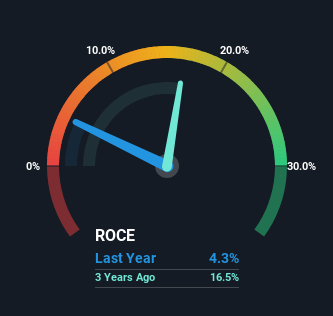- China
- /
- Electrical
- /
- SZSE:301238
Be Wary Of Jiangsu Ruitai New Energy Materials (SZSE:301238) And Its Returns On Capital

If we want to find a potential multi-bagger, often there are underlying trends that can provide clues. One common approach is to try and find a company with returns on capital employed (ROCE) that are increasing, in conjunction with a growing amount of capital employed. Basically this means that a company has profitable initiatives that it can continue to reinvest in, which is a trait of a compounding machine. Having said that, from a first glance at Jiangsu Ruitai New Energy Materials (SZSE:301238) we aren't jumping out of our chairs at how returns are trending, but let's have a deeper look.
Understanding Return On Capital Employed (ROCE)
Just to clarify if you're unsure, ROCE is a metric for evaluating how much pre-tax income (in percentage terms) a company earns on the capital invested in its business. The formula for this calculation on Jiangsu Ruitai New Energy Materials is:
Return on Capital Employed = Earnings Before Interest and Tax (EBIT) ÷ (Total Assets - Current Liabilities)
0.043 = CN¥358m ÷ (CN¥11b - CN¥2.3b) (Based on the trailing twelve months to March 2024).
Therefore, Jiangsu Ruitai New Energy Materials has an ROCE of 4.3%. In absolute terms, that's a low return and it also under-performs the Electrical industry average of 6.0%.
Check out our latest analysis for Jiangsu Ruitai New Energy Materials

While the past is not representative of the future, it can be helpful to know how a company has performed historically, which is why we have this chart above. If you want to delve into the historical earnings , check out these free graphs detailing revenue and cash flow performance of Jiangsu Ruitai New Energy Materials.
What The Trend Of ROCE Can Tell Us
On the surface, the trend of ROCE at Jiangsu Ruitai New Energy Materials doesn't inspire confidence. Over the last five years, returns on capital have decreased to 4.3% from 13% five years ago. Given the business is employing more capital while revenue has slipped, this is a bit concerning. If this were to continue, you might be looking at a company that is trying to reinvest for growth but is actually losing market share since sales haven't increased.
On a related note, Jiangsu Ruitai New Energy Materials has decreased its current liabilities to 21% of total assets. So we could link some of this to the decrease in ROCE. Effectively this means their suppliers or short-term creditors are funding less of the business, which reduces some elements of risk. Some would claim this reduces the business' efficiency at generating ROCE since it is now funding more of the operations with its own money.
In Conclusion...
In summary, we're somewhat concerned by Jiangsu Ruitai New Energy Materials' diminishing returns on increasing amounts of capital. Investors haven't taken kindly to these developments, since the stock has declined 17% from where it was year ago. Unless there is a shift to a more positive trajectory in these metrics, we would look elsewhere.
Since virtually every company faces some risks, it's worth knowing what they are, and we've spotted 3 warning signs for Jiangsu Ruitai New Energy Materials (of which 2 are concerning!) that you should know about.
For those who like to invest in solid companies, check out this free list of companies with solid balance sheets and high returns on equity.
New: Manage All Your Stock Portfolios in One Place
We've created the ultimate portfolio companion for stock investors, and it's free.
• Connect an unlimited number of Portfolios and see your total in one currency
• Be alerted to new Warning Signs or Risks via email or mobile
• Track the Fair Value of your stocks
Have feedback on this article? Concerned about the content? Get in touch with us directly. Alternatively, email editorial-team (at) simplywallst.com.
This article by Simply Wall St is general in nature. We provide commentary based on historical data and analyst forecasts only using an unbiased methodology and our articles are not intended to be financial advice. It does not constitute a recommendation to buy or sell any stock, and does not take account of your objectives, or your financial situation. We aim to bring you long-term focused analysis driven by fundamental data. Note that our analysis may not factor in the latest price-sensitive company announcements or qualitative material. Simply Wall St has no position in any stocks mentioned.
About SZSE:301238
Jiangsu Ruitai New Energy Materials
Jiangsu Ruitai New Energy Materials Co., Ltd.
Moderate with adequate balance sheet.
Market Insights
Community Narratives




